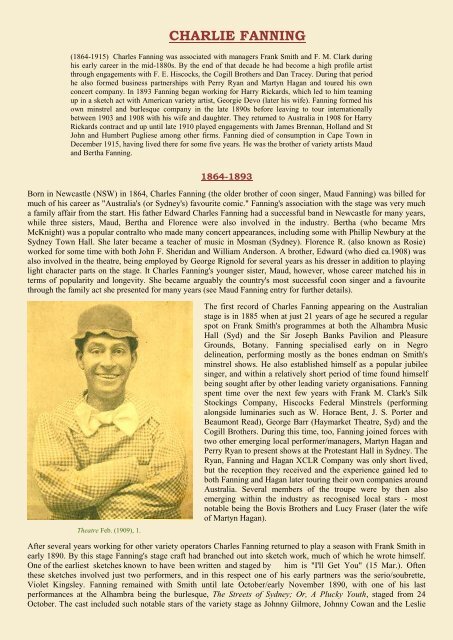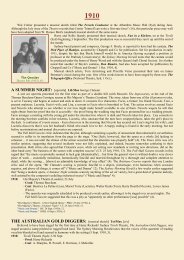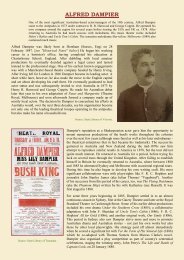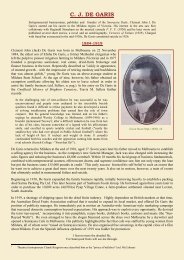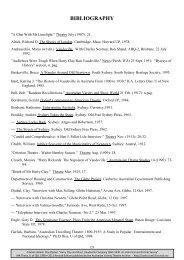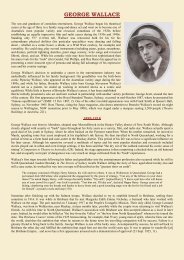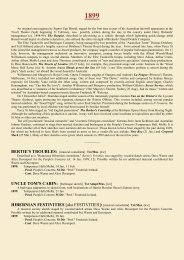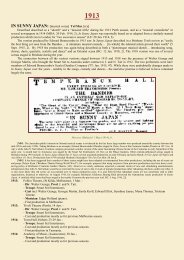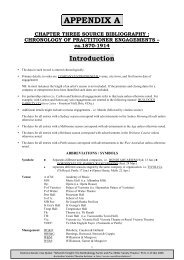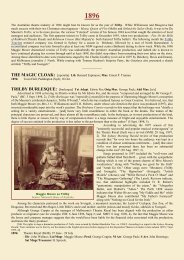CHARLIE FANNING - Australian Variety Theatre Archive
CHARLIE FANNING - Australian Variety Theatre Archive
CHARLIE FANNING - Australian Variety Theatre Archive
You also want an ePaper? Increase the reach of your titles
YUMPU automatically turns print PDFs into web optimized ePapers that Google loves.
<strong>CHARLIE</strong> <strong>FANNING</strong><br />
(1864-1915) Charles Fanning was associated with managers Frank Smith and F. M. Clark during<br />
his early career in the mid-1880s. By the end of that decade he had become a high profile artist<br />
through engagements with F. E. Hiscocks, the Cogill Brothers and Dan Tracey. During that period<br />
he also formed business partnerships with Perry Ryan and Martyn Hagan and toured his own<br />
concert company. In 1893 Fanning began working for Harry Rickards, which led to him teaming<br />
up in a sketch act with American variety artist, Georgie Devo (later his wife). Fanning formed his<br />
own minstrel and burlesque company in the late 1890s before leaving to tour internationally<br />
between 1903 and 1908 with his wife and daughter. They returned to Australia in 1908 for Harry<br />
Rickards contract and up until late 1910 played engagements with James Brennan, Holland and St<br />
John and Humbert Pugliese among other firms. Fanning died of consumption in Cape Town in<br />
December 1915, having lived there for some five years. He was the brother of variety artists Maud<br />
and Bertha Fanning.<br />
1864-1893<br />
Born in Newcastle (NSW) in 1864, Charles Fanning (the older brother of coon singer, Maud Fanning) was billed for<br />
much of his career as "Australia's (or Sydney's) favourite comic." Fanning's association with the stage was very much<br />
a family affair from the start. His father Edward Charles Fanning had a successful band in Newcastle for many years,<br />
while three sisters, Maud, Bertha and Florence were also involved in the industry. Bertha (who became Mrs<br />
McKnight) was a popular contralto who made many concert appearances, including some with Phillip Newbury at the<br />
Sydney Town Hall. She later became a teacher of music in Mosman (Sydney). Florence R. (also known as Rosie)<br />
worked for some time with both John F. Sheridan and William Anderson. A brother, Edward (who died ca.1908) was<br />
also involved in the theatre, being employed by George Rignold for several years as his dresser in addition to playing<br />
light character parts on the stage. It Charles Fanning's younger sister, Maud, however, whose career matched his in<br />
terms of popularity and longevity. She became arguably the country's most successful coon singer and a favourite<br />
through the family act she presented for many years (see Maud Fanning entry for further details).<br />
<strong>Theatre</strong> Feb. (1909), 1.<br />
The first record of Charles Fanning appearing on the <strong>Australian</strong><br />
stage is in 1885 when at just 21 years of age he secured a regular<br />
spot on Frank Smith's programmes at both the Alhambra Music<br />
Hall (Syd) and the Sir Joseph Banks Pavilion and Pleasure<br />
Grounds, Botany. Fanning specialised early on in Negro<br />
delineation, performing mostly as the bones endman on Smith's<br />
minstrel shows. He also established himself as a popular jubilee<br />
singer, and within a relatively short period of time found himself<br />
being sought after by other leading variety organisations. Fanning<br />
spent time over the next few years with Frank M. Clark's Silk<br />
Stockings Company, Hiscocks Federal Minstrels (performing<br />
alongside luminaries such as W. Horace Bent, J. S. Porter and<br />
Beaumont Read), George Barr (Haymarket <strong>Theatre</strong>, Syd) and the<br />
Cogill Brothers. During this time, too, Fanning joined forces with<br />
two other emerging local performer/managers, Martyn Hagan and<br />
Perry Ryan to present shows at the Protestant Hall in Sydney. The<br />
Ryan, Fanning and Hagan XCLR Company was only short lived,<br />
but the reception they received and the experience gained led to<br />
both Fanning and Hagan later touring their own companies around<br />
Australia. Several members of the troupe were by then also<br />
emerging within the industry as recognised local stars - most<br />
notable being the Bovis Brothers and Lucy Fraser (later the wife<br />
of Martyn Hagan).<br />
After several years working for other variety operators Charles Fanning returned to play a season with Frank Smith in<br />
early 1890. By this stage Fanning's stage craft had branched out into sketch work, much of which he wrote himself.<br />
One of the earliest sketches known to have been written and staged by him is "I'll Get You" (15 Mar.). Often<br />
these sketches involved just two performers, and in this respect one of his early partners was the serio/soubrette,<br />
Violet Kingsley. Fanning remained with Smith until late October/early November 1890, with one of his last<br />
performances at the Alhambra being the burlesque, The Streets of Sydney; Or, A Plucky Youth, staged from 24<br />
October. The cast included such notable stars of the variety stage as Johnny Gilmore, Johnny Cowan and the Leslie
Brothers. Following his engagement with Smith, Fanning joined forces briefly with H. Florack's newly reformed<br />
Federal Minstrels Company. This company, which also included Harry Clay, had created some waves the previous<br />
year when they appropriated the moniker previously made popular by F. E. Hiscocks.<br />
During the early 1890s Fanning cemented his reputation as one of the country's leading comedy singers, sketch writers<br />
and refined specialty artists. Always popular with Sydney audiences he played occasional return engagements with<br />
Frank Smith between top of the bill engagements with entrepreneurs like Dan Tracey and Harry Barrington (who took<br />
over Smith's Alhambra operations in early 1893), or with his own minstrels troupe at popular weekend venues like the<br />
Bondi Aquarium. The line-up in 1890 included his sisters Maud and Bertha, J. Whitworth and Lorrie St. George<br />
among others. One of Fanning's more popular sketches around this time was the Ethiopian burlesque, "The Bruised<br />
Heart," staged at the Alhambra on 19 Mar. 1892. With Smith, too, he increased his profile by playing hilarious<br />
characters in such farces as "Hard to Kill" (5 Sept. 1892) and "A Night in Woolloomooloo" (26 Mar. 1892). During<br />
the same period he occasionally toured his own company around the eastern states. One known tour was in late 1891.<br />
It was this time onwards that Fanning's billing in advertising began to include such slogans as: "Australia's favourite<br />
comic," "the Mogul of Minstrelsy," "King of Ethiopian Comedians" and "Sydney's ever-favourite comedian." Such<br />
was Fanning's popularity with audiences and critics alike by this stage that in September 1893, Harry Rickards offered<br />
him a season at his newly built Tivoli <strong>Theatre</strong>. A few weeks into his season the Sydney Morning Herald devoted a<br />
good deal of space in its review of the current show to Fanning:<br />
A new laughable absurdity [presented by Mr Charles Fanning] consisted of a breathless narrative of impossible<br />
doings in high places, delivered with a mirth-provoking air of honesty and good faith.; he was encored for a ditty<br />
about "Joanna," sang a parody, of which the burthen was "the man who's breaking stones at Monte Carlo;" and<br />
displayed a capital falsetto voice in the popular Neapolitan barcarole, "Funiculi, Funicula" (9 Oct. 1893, 6).<br />
The timing of Charles Fanning's engagement with Rickards was fortunate for several reasons, first because it was a<br />
period when variety's fortunes were being seriously threatened as a result of the late 1880s/early 1890s economic<br />
collapse. In this respect Rickards was the only one of his peers at the top end of the industry to be able to manage to<br />
continue operating at this level through to the end of the decade, hence providing high quality local performers artist<br />
like Fanning with much needed financial security. The second reason was both professional and personal.<br />
1894-1897<br />
While Fanning was on the bill of the Sydney Tivoli in September 1893 the company was joined by English marionette<br />
comedian Fred Davys and his American partner, soubrette Georgie Devoe. The couple had been touring the<br />
Antipiodes since 1888, most of that time under Rickards management. By the time of this engagement, however, their<br />
relationship was breaking down, and indeed by the end of the year they appeared on their last bill together before<br />
separating. In August 1894 Devoe debuted with Harry Barrington's company at the Alhambra Music Hall, Sydney. A<br />
few weeks later the line-up was strengthened with the inclusion of several new artists, including Fanning. On 15<br />
September the two artists returned to the Sydney Tivoli for Harry Rickards, presenting their own solo turns. The<br />
following week they appeared together for the first time in a sketch act.<br />
Sydney Morning Herald 22 Sept. (1894), 2.<br />
From this point onwards Fanning and Devoe worked almost exclusively together, both as solo artists and as sketch<br />
partners. They also appeared with other performers in various specialty entertainments, musical comedies and<br />
burlesques and so forth. It's clear from advertising over the course of the remainder of the 1890s, however, that<br />
Fanning was regarded as one of the feature performers in any company he appeared in, despite being on the same bills<br />
as top-liners Charlie Pope and Irving Sayles, Will Whitburn, Priscilla Verne, Harry Shine and the Bovis Bros to name<br />
just a handful. While Devoe and Fanning are known to have been engaged by a number of different management firms<br />
during the remainder of the 1890s, including the Cogill Bros, that five year period saw them mostly associated with<br />
Harry Rickards, and in particular his venues in Sydney and Melbourne.
The 1890s also saw Fanning develop his creative abilities, writing numerous sketches and minstrel farces. One<br />
particular favourite, and which is believed to have been adapted by other local companies over the next decade or so<br />
was his original comedy sketch, "The Asylum" (9 Feb. 1895). The premiere production included among its cast<br />
Fanning and Devoe, Charlie Pope, Irving Sayles and Florrie St Clair. Another highlight of his long Rickards<br />
engagement was the pantomime, Jack the Giant Killer (22 Mar. 1898) in which he played the part of Merlyn. During<br />
the year he also staged two burlesque sketches – "Hamlet" (2 Apr.) and "The Far Beyond" (12 Nov.). The balcony<br />
scene from Fanning's burlesque on Hamlet was to become a regular attraction for Fanning and Devoe over the course<br />
of their later career, with the first known staging being at the Bijou <strong>Theatre</strong> (Melb) on 14 January the following year.<br />
Three of his more popular turns during Rickards 1899 Melbourne Opera House season were the burlesque sketches<br />
"Heavy Weightlifting and Chain Breaking" (14 Jan.), "The Melbourne Cup in Five Minutes" and a spoof on imported<br />
star, Cinquevalli (4 Nov.). By the end of 1899 Fanning had put together his own company for a season at the<br />
Protestant Hall, Sydney. Given his already high industry profile it is of little surprise, too, that the troupe,<br />
billed as Charlie Fanning's Minstrel and Burlesque Company, comprised a stellar line-up of local and<br />
"imported" artists, – notably Priscilla Verne, Walter Reed, Johnny Cowan, Ted Sutton, Harry Carlton, Lillie<br />
Linton, Wal Cottier, Hetty Patey, Mabel Lynne, Sisters Gallardy, Millar Fraser, Arthur Crane, The Two Ks.<br />
Also in the company was his new wife, the pair having married in Sydney on 19 January the previous year.<br />
Mrs Charlie Fanning - Georgie Devoe<br />
<strong>Theatre</strong> Feb. (1909), 9.<br />
1900-1910<br />
Charlotte Fanning<br />
<strong>Theatre</strong> Feb. (1909), 9.<br />
In early 1900 Fanning and Devoe's daughter Charlotte was born in Melbourne. Soon afterwards they travelled to<br />
Western Australia to take up a contract with Jones and Lawrence at the Cremorne Gardens (Perth). They likely also<br />
toured the Murchison goldfield circuit during this period. The pair made a huge impression on Perth audiences, and<br />
found their performances being recalled time and again. The West <strong>Australian</strong> notes of Fanning's stage presence: "His<br />
style is quaint and original, and the absence of vulgarity is the leading characteristic of his specialty work" (19 Feb.<br />
1900, 3). One of the more popular solo turns staged by Fanning was "The Albany Cup in Five Minutes" (likely an<br />
adaptation of his Melbourne routine), which the paper indicates was a satire of a "bookmaker with a mania for laying<br />
long-odds" (5 Feb. n. pag.). Perhaps his greatest successes there, however, were his parodies of patriotic songs and<br />
songs that were then the current rage - including "Caller Herrin," "When Other Lips" and "The Absent-Minded<br />
Bushy." He is also said to have performed a burlesque contortion act that satirised the Tyler Risley act and presented a<br />
scream of an act in a burlesque of a prima donna.<br />
Their next major engagement was with John Fuller and Sons, first in New Zealand where they played seasons in<br />
Auckland and Wellington in late 1900/early 1901. Interestingly Fred Davys was also in New Zealand around the same<br />
time, but while Devoe and Fanning were on the North Island he was on the South Island appearing in Dunedin for<br />
Percy Dix. Devoe and Fanning returned to Sydney in March 1891 and joined the Fullers at the start of their 12
months stay at the Empire <strong>Theatre</strong>. The couple made their reappearance "after a prolonged absence" on 22 June,<br />
remaining with the company through until at least early July. By December that same year they were back in New<br />
Zealand, playing a season at the <strong>Theatre</strong> Royal, Wellington, but this time under the management of Percy Dix. John<br />
Fuller re-engaged them in 1902 as headline acts for his Polite Empire Entertainers. They played their first show in late<br />
April at Launceston. A month later Fuller transferred them to Hobart's Temperance Hall.<br />
Although their precise whereabouts between the 1902<br />
Hobart engagement in 1902 and September 1908 are yet to<br />
be established, Fanning and Devoe the entire six years. A<br />
letter from Fanning written in England in early 1903, which<br />
was published in several <strong>Australian</strong> newspapers [see right]<br />
indicates that he had already played a successful engagement<br />
in South Africa by that time (see right). Research undertaken<br />
by Michael Raynor has also uncovered a brief article<br />
published in Perth's Western Mail on 27 September 1902<br />
which reports that Devoe and Fanning had recently been<br />
performing in Cape Town. Raynor further notes the family,<br />
listed as Mr C. Faning, Mrs Faning and Master Faning [sic]<br />
sailed from Cape Town on 8 October for Southhampton,<br />
England, aboard the S. S. St Louis (Master Faning was<br />
Devoe and Davys' son Frederick 1 ). As "Charlotte was an<br />
infant," writes Raynor, she was "not mentioned in the<br />
passenger list."<br />
In his 12 January 2012 research document Raynor writes<br />
that Devoe was very likely still working professionally<br />
around this time but he is yet to uncover any advertising or<br />
reviews with her name mentioned. What he has discovered,<br />
however, is that Devoe and her daughter sailed from<br />
Queenslander 7 Mar. (1903), 514.<br />
Liverpool to New York at least twice between 1903 and<br />
1906. They left Southhampton the first time on 7 March<br />
aboard the S.S. St Paul. The second trip saw them arrive back in New York on 15 February 1906 aboard the S.S.<br />
Majestic. "The United Kingdom Incoming Passenger Lists 1878-1969 [available via Ancestry.com] records that the<br />
pair returned to England mid-year via Buenos Aires (having left on the Argentinean capital on 23 June. Earlier<br />
Fanning had travelled from Liverpool to New York, arriving on 20 May before heading south the Argentina -<br />
presumably with, or to meet up with his wife and daughter. Raynor notes with some interest that the comedian listed<br />
his occupation at that time as a "theatrical agent."<br />
Fanning is recorded as being back in New York in early<br />
January 1907, billed as the "<strong>Australian</strong> Comedian and the<br />
Man with a Voice" (New York Morning Telegraph, 8 Jan.<br />
1907, n. pag.). Whilst the whereabouts of Georgie Devoe<br />
and Charlotte is again unknown, Raynor believes that<br />
they would have also been working - either in Great<br />
Britain or the USA. Two issues of the <strong>Theatre</strong> magazine<br />
from 1909 provide a little more information on the career<br />
movements of the Fannings during their time in Great<br />
Britain, recording that the couple played such venues as<br />
the South London Palace of Varieties, Oxford Palace<br />
(Middlesbrough), Barnards Palace of Varieties<br />
(Greenwich) and London's Royal Standard Music Hall<br />
(Jan. 1909, 15; and Feb. 1909, 9).<br />
What has been ascertained in terms of their movements is that the Fannings returned to Australia in 1908 under<br />
contract to Harry Rickards, 2 arriving in Perth on 2 October. Eighteen days later they were the feature artists for<br />
Rickards Tivoli Vaudeville Company's opening show at the Palace Gardens. Later that year the couple and their<br />
daughter also toured the Western <strong>Australian</strong> goldfield towns, playing Kalgoorlie around Christmas/New Year. On 1<br />
1 See "Historical Notes and Corrections" section for further details uncovered by Michael Raynor regarding Frederick Davys' movements<br />
around the early 1900s in relation to his mother and father.<br />
2 See "Additional Quotations" section below for an interview with Charles Fanning upon his return to Australia in 1908, in which he refers<br />
to his overseas experieneces.<br />
Mercury (Hobart) 5 June (1909), 6.
May the following year they opened at Melbourne's Opera House. Although the <strong>Theatre</strong> reports that the Fannings had<br />
signed a two year contract with the Tivoli organisation (Feb. 1909, 9), this must have been either shortened or<br />
undertaken on a casual basis as the couple accepted a number of alternate engagements during their two years back in<br />
the country. Following the Melbourne season the family travelled to Hobart, where they opened on 29 May with<br />
Lucas' Grand Tivoli Vaudeville Co (no relation to Harry Rickards' organisation). 3<br />
Over the next two years Fanning and Devoe played seasons with James Brennan in Melbourne (Gaiety <strong>Theatre</strong>) and<br />
Sydney (National Amphitheatre), Holland and St John (Bris) and C.F. and H. Pugliese (Alhambra <strong>Theatre</strong>, Syd). The<br />
Brisbane Courier records that two particular highlights of the Fanning/Devoe turn during their 1910 Empire <strong>Theatre</strong><br />
season were their "Romeo and Juliet" burlesque (16 July 1910) and a motoring burlesque that "started off in an<br />
extremely fantastic fashion" (5 Sept. 1910, n. pag.). Although Fanning had initially indicated that he and his wife<br />
planned to remain in Australia, by 1910 they had made the decision to go back to settle in South Africa. Before leaving<br />
Australia they played at least two engagements in Sydney and Brisbane.<br />
Sometime after late 1910 Fanning left for South Africa where he settled, presumably still performing with his wife and<br />
daughter. In its 5 January 1916 issue, <strong>Australian</strong> <strong>Variety</strong> reported: "For many years Australia's foremost cornermen<br />
and blackface comedian… Charles Fanning is dying of consumption in Somerset Hospital, Cape Town (4). However,<br />
according to a report published in the West <strong>Australian</strong> on 29 January, Fanning had by then already died on 6<br />
December 1915. In reporting Fanning's death in its March 1916 issue, the <strong>Theatre</strong> presented in detail one of his patter<br />
turns, "Push and Pull." The same journalist (who recalled the patter from some five years previous) goes on to note<br />
that "with his wobbly-gobbly way of speaking there was never, particularly in respect of patter, a more amusing blackfaced<br />
comedian than Mr Fanning heard in Australia" (n. pag.). In The Streets of Sydney, Isadore Brodsky provides<br />
further insight into the type of relationship and standing Fanning had with his adoring public during the prime of his<br />
career:<br />
His first turn appealed to a bunch of jockey boys in the audience and in devilment they sent up a bouquet at the<br />
end of the turn - a bunch of carrots. Said Charlie: "Thank you boys, but you haven't sent the corned beef with<br />
this." At [the] interval the boys whipped over to paddy's Markets to atone for their thoughtfulness [sic]. Fanning<br />
came on after the intermission and completed his popular turn. And then he got the big surprise. It was the<br />
corned beef. The jockey's three a huge round of smoking beef onto the stage - the entire stock of a market<br />
stallholder. Ah! for the old days of Paddy's Markets and Campbell Street, old-timers will say with a sigh" (127).<br />
It is presently unclear what happened to Fanning's wife and daughter in the immediate years following his death.<br />
Michael Raynor, the grandson of Devoe's first partner Fred Davys has conducted research which shows mother and<br />
daughter returned to the USA via the Great Britain in 1920. On the shipping manifest both Georgie and Charlotte are<br />
listed as actresses. Devoe also stated that they had been living at 38 <strong>Theatre</strong> Road Calcutta, India with a friend C. L.<br />
Phillipps [sic]. How long they resided there is unclear. [See Georgie Devoe's entry for further details of her movements and<br />
those of their daughter Charlotte]<br />
SEE ALSO<br />
• Maud Fanning • Georgie Devoe<br />
ADDITIONAL QUOTATIONS<br />
• Charles Fanning seems to be making a do of it with his vaudeville show at [the] Sydney Opera House,<br />
where the artists are Walter Reed in the centre, Johnny Cowan, Ted Sutton, Harry Carlton and Charles<br />
Fanning on the corners, Lillie Linton, Hetty Patey, Mabel Lynne, Sisters Gallardy, Georgie Devoe,<br />
Millar Fraser, and Arthur Crane. "The Two Ks" do their old-time bycle act of '89, and Charles Fanning<br />
gives an amusing burlesque on the world's juggler and balancer, entitled "Paul Kruger Sink-in-the-<br />
Valley" (OW: 8 Feb. 1900, 51).<br />
NB: The writer incorrectly identifies the venue as the Opera House, when it was in fact the Protestant Hall.<br />
• Charlie Fanning's face is a wonder in itself, and like the maid of the song it is his fortune. But all his<br />
merit is not confined to his face, which is as plastic as it is grotesque in its mobility as are politicians on<br />
the jelly-fish. He talks patter by the yard – a yard where no weeds grow for his "patter" though just the<br />
same is as fresh as it was when I heard it first as the old Haymarket and the newly-opened Tivoli; it must<br />
be a dozen years ago (STP: 11 Feb. 1900, 5).<br />
3 It is assumed that the artist billed as Little Sharlotta was in fact Charlotte Fanning.
• Charles Fanning – "let 'em all come" – was neatly sold on his recent arrival in Perth. On reaching his<br />
hotel he was met by a friend, who introduced a city wag as the reporter of the local buster, and the latter<br />
requested an interview as to the future of the British stage, with a special reference to the burnt cork<br />
section. Charles let himself out volubly, and after rattling off for half-a-dozen interviews, paused to ask<br />
the name of the paper and how many copies he was expected to take. Then the "interviewer" winked at<br />
the friend, and the friend winked at Charles, who winked back his acknowledgement of the "sell."<br />
Fanning has since made another addition to his repertoire of songs. It is "One of his legs is longer than it<br />
really ought to be," and he sings it feelingly (OBS: 3 Mar. 1900, 6)<br />
• Charlie Fanning, one of London's favourite comedians, and an artist of exceptional ability, returned to<br />
Australia by the R.M.S. Oroya to-day, in company with his wife and eight-year old little girl. He<br />
informed a Daily News reporter that he had come out to Australia under management to Harry Rickards<br />
and would commence a season at Perth…. "I have done remarkably well," said he, "since I left Australia<br />
six years ago. I have been doing three halls nightly in London and performed throughout the provinces<br />
of England with Cinquevalli and Little Tich. I also enjoyed a six months tour through the United States.<br />
Do I intend to reside permanently in Australia? Well, rather." A ship's official informer our<br />
representative that Mr, Mrs and Miss Fanning had been the light and soul on board the Oroya on her trip<br />
out (DNP: 8 Oct. 1908, 8).<br />
ORIGINAL FARCES AND SKETCHES<br />
1890: I'll Get You (sk)<br />
1892: The Bruised Heart (sk)<br />
1895: The Asylum (f) • Hamlet (sk) • The Far Beyond (sk)<br />
1899: Weightlifting and Chain Breaking (sk) • The Melbourne Cup in Five Minutes (sk)<br />
1902: The Clockmaker (f)<br />
TROUPES<br />
Charlie Fanning Concert Party • Charlie Fanning Co • Charlie Fanning's Minstrel & Burlesque Co •<br />
Cogill Bros' Minstrels • Dan Tracey Minstrels • Dan Tracey & Harry Rickards' New Musical Comedy Co •<br />
F.M. Clark's Silk Stockings • Harry Rickards' New Comedy & Specialty Co • Harry Rickards' New English & Irish Co<br />
• Harry Rickards' New Musical & Specialty Co • Harry Rickards' New English Co • H. Florack's Federal Minstrels •<br />
Hiscocks' Federal Minstrels • Protestant Hall Co • Ryan, Fanning & Hagen XCLR Co<br />
ENGAGEMENTS CHRONOLOGY<br />
Incl. Bertha Fanning, and Georgie Devoe (1894 - )<br />
* = Details regarding length of engagement are yet to be established<br />
1885: FRANK SMITH (Alhambra MH, Syd; ca. 23 May*)<br />
1886: FRANK SMITH (Alhambra MH, Syd; ca. 24 July*)<br />
1887: F. M. CLARK (Lse. Clark & F. E. Hiscocks > Vic Hall, Melb; ca. 4 June.* > Silk Stocking Co)<br />
1888: F. E. HISCOCKS (A of M, Syd; ca. 21 Jan.* > Federal Minstrels) ► PROTESTANT HALL Co (Prot Hall, Syd;<br />
ca. 14 July*) ► RYAN, <strong>FANNING</strong> & HAGEN XCLR Co (Prot Hall, Syd; ca. 8 Sept.*) ► GEORGE BARR<br />
(Haymarket MH, Syd; ca. 20 Oct.*) ► PROTESTANT HALL Co (Prot Hall, Syd; ca. 17 Nov.*)<br />
1889: FRANK SMITH (Bertha Fanning > Alhambra MH, Syd; ca. 28 Jan.*) ► COGILL BROS MINSTRELS (St<br />
Geo's Hall, Melb; ca. 9 Nov. - *)<br />
1890: FRANK SMITH (Alhambra MH, Syd; ca. 8 Feb.*) ► H. FLORACK'S FEDERAL MINSTRELS (+ Bertha<br />
Fanning > Bondi Aquarium, Syd; 8 Nov.) ► BONDI AQUARIUM (Syd; ca. 6 Dec.*) ► <strong>CHARLIE</strong> <strong>FANNING</strong><br />
CONCERT Co (Prot Hall, Syd; ca. 13 Dec.*) • (Bondi Aquarium, Syd; 13 Dec.)<br />
1891: DAN TRACEY (+ Bertha Fanning > S of A, Syd; ca. 3 Jan.*) ► FRANK SMITH (Alhambra MH, Syd; ca. 24<br />
Oct.*)<br />
1892: DAN TRACEY (+ Bertha Fanning > S of A, Syd; ca. 13 Feb.*) ► FRANK SMITH (Alhambra Th, Syd; ca. 26<br />
Mar.*) ► FRANK SMITH (Alhambra MH, Syd; 1 Aug - ca. Sept.*) ► TRACEY & RICKARDS (+ Bertha<br />
Fanning > from 12 Nov. > S of A, Syd; ca. 13 Sept. - * > Tracey Co and Rickards New Musical Comedy Co)<br />
1893: DAN TRACEY Co (+ Bertha Fanning > Gaiety Th, Syd; ca .25 Feb.*) ► n/e (Gaiety Th, Syd; 3 Mar.* > Alf M.<br />
Hazlewood benefit) ►HARRY BARRINGTON (Alhambra Th, Syd; 25 Feb.*) ► HARRY RICKARDS (Tivoli<br />
Th, Syd; 23 Sept. - * > company also incl. Georgie Devoe and Fred Davys)
1894: HARRY BARRINGTON (Alhambra Th, Syd; 4 Aug. - * > Harry Barrington's <strong>Variety</strong> & Burlesque Co) ► HARRY<br />
RICKARDS (Tivoli Th, Syd; 15 Sept. - ca Nov.) ► COGILL BROS (Oxford Th, Melb; 10 Nov. - 31 Dec. ><br />
Cogills' Minstrel & Burlesque Co)<br />
NB: All entries from 1895 onwards are for Georgie Devoe and Charlie Fanning unless otherwise noted)<br />
1895: COGILL BROS (Oxford Th, Melb; 1 Jan. - * > Cogills' Minstrel & Burlesque Co) ► HARRY RICKARDS (Tivoli<br />
Th, Syd; 19 Jan. - *)<br />
NB: See also SMH adverts. June - October.<br />
1896: HARRY RICKARDS (Qld tour; ca. Oct/Nov.* > Incl. Charters Towers, 30 Oct.)<br />
1897: HARRY RICKARDS (Tivoli Th, Syd; ca. Jan.*) • (Op House, Melb; ca. 13 Mar.* > See also adverts in the Age:<br />
Apr. - July) • (Tivoli Th, Syd; ca. 31 July*)<br />
1898: HARRY RICKARDS (Tivoli Th, Syd; ca. 22 Mar.*) • (Op House, Melb; ca. 28 May*) • (Op House, Melb;<br />
ca. 13 Aug.*) • (Tivoli Th, Syd; ca. 24 Sept.*) • (Op House, Melb; ca. 24-31 Dec.*)<br />
1899: HARRY RICKARDS (Op House, Melb; 1 Jan. - *) • (Bijou Th,<br />
Syd; ca. 6 Feb.*) • (Tivoli Th, Syd; ca. 4 Mar.*) ► n/e<br />
(Parramatta TH, Syd; 18 Apr. > benefit) ► CHARLES <strong>FANNING</strong><br />
(Op House, Syd; 4 Nov.* > Charles Fanning Co) • NEWBURY/<br />
SPADA (Bertha Fanning > Sydney TH; 6, 11 Nov.* > Shilling Pops<br />
Concerts) ► <strong>CHARLIE</strong> <strong>FANNING</strong> (Prot Hall, Syd; 23 Dec.* ><br />
Fanning's Minstrel & Burlesque Co)<br />
1900: <strong>CHARLIE</strong> <strong>FANNING</strong> (Prot Hall, Syd; 1 Jan. - *> Fanning's<br />
Minstrel & Burlesque Co) ► JONES & LAWRENCE (Cremorne<br />
Gardens, Perth; 29 Jan. - 26 Mar.) ► JOHN FULLER<br />
(Agricultural Hall, Auckland, NZ; 10 Oct. - * > Fuller's Bijou Co) •<br />
(Choral Hall, Wellington; 1 Dec. - * > Fuller's Bijou Co)<br />
1901: JOHN FULLER (Empire Th, Syd; ca. June/July * > Fullers Empire<br />
Co) • (Th Royal, Wellington, NZ; 24-31 Dec.)<br />
1902: JOHN FULLER (Th Royal, Wellington, NZ; 1 Jan. - *) •<br />
(Empire Th, Launceston; 22 Apr. - 30 May > Fullers Polite<br />
Empire Entertainers) • (Temp Hall, Hobart; 31 May - * > Fullers<br />
Sydney Morning Herald 23 Dec. (1899), 2.<br />
Polite Empire Entertainers)<br />
NB: 1902-1908: Fanning and Devoe spent the years 1903 to 1908 overseas, playing engagements in Great Britain, the USA,<br />
South Africa and possibly Argentina. Among the theatres they appeared in while in England were: the South London<br />
Palace of Varieties, Oxford Palace (Middlesbrough), Barnards Palace of Varieties (Greenwich), Royal Standard Music<br />
Hall (London). See TT: Jan. 1909, 15 and Feb. 1909, 9).<br />
1908: HARRY RICKARDS (Palace Gardens, Perth; ca. 20 Oct. - 13 Nov.) • (Western <strong>Australian</strong> Goldfields tour;<br />
incl. (Cremorne Gardens, Kalgoorlie, WA; ca. Dec. *)<br />
1909: HARRY RICKARDS (Western <strong>Australian</strong> Goldfields tour; incl. (Cremorne Gardens, Kalgoorlie, WA; ca.<br />
Jan. *) • (Tivoli Th, Adel; 29 Mar. - *) • (Op House, Melb; 24 Apr. - *) ► M. LUCAS (Temp Hall, Hobart;<br />
29 Jan. > Lucas' Grand Tivoli Vaudeville Co) ► JAMES BRENNAN (Nat Amph, Syd; 18 Sept.* > See TT: Oct. 1909,<br />
22-3) • (Gaiety Th, Melb; 13 Nov.*) ► n/e (New Empire Th, Launceston; 25-31 Dec.)<br />
NB: The 25 December Launceston show was a special Christmas concert.<br />
1910: n/e (New Empire Th, Launceston; 1 Jan. - 3 Feb.) ► HUMBERT PUGLIESE (Alhambra Th, Syd; 18 June -<br />
*) ► HOLLAND & ST JOHN (Th Royal, Bris; ca. 2 July*) ► HUMBERT PUGLIESE (Alhambra Th, Syd;<br />
24 Sept. - *)<br />
FURTHER REFERENCE<br />
Brodsky, Isadore. Streets of Sydney (1962), 127.<br />
Djubal, Clay. "Fanning, Charlie." AustLit (2007).<br />
"Pars About People." OBS: 3 Mar. (1900), 6.<br />
"Popular Comedian: Mr Charles Fanning Returns to Australia, A." DNP: 8 Oct. (1908), 8.<br />
"Stage Gossip." OW: 8 Feb. (1900), 51.<br />
The AVTA acknowledges the research of Michael Raynor, particularly the information in<br />
this biography pertaining to Charles Fanning and Georgie Devoe's movements after 1910.<br />
Last updated: 12/06/2012<br />
Expanded and updated from Clay Djubal, "What Oh Tonight." Ph D Diss. U of Qld (2005), Appendix D.<br />
NB: The URL for this PDF will change each time it is updated. If you wish to cite or link to this record please use the following:<br />
<strong>Australian</strong> <strong>Variety</strong> <strong>Theatre</strong> <strong>Archive</strong> • http://ozvta.com/practitioners-f/


